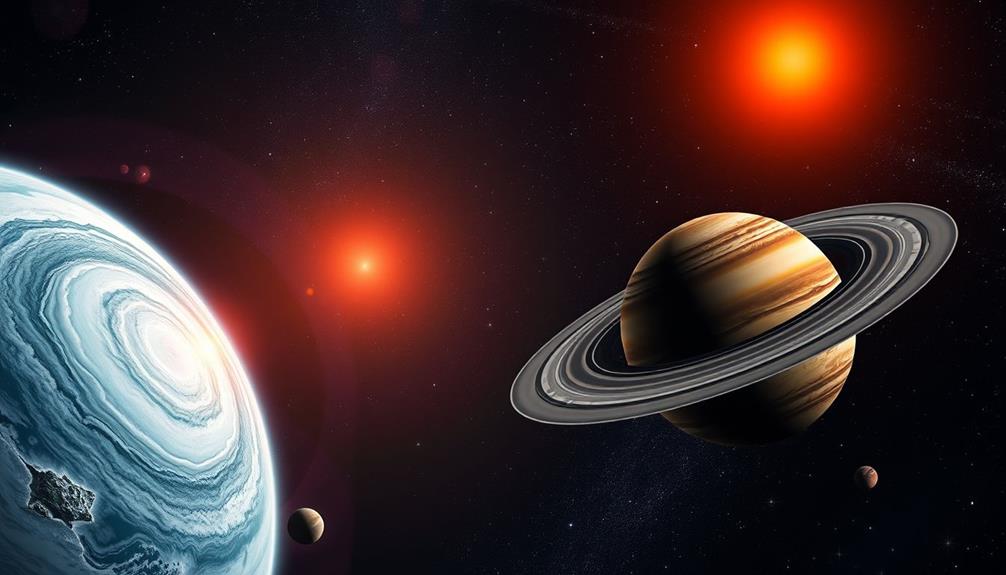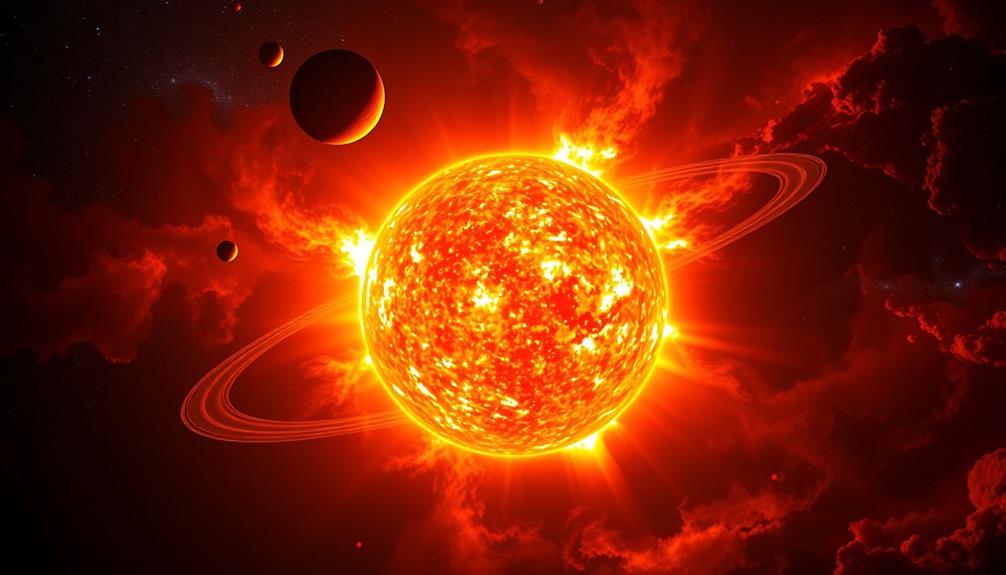Space exploration is packed with mind-blowing facts that spark your imagination. Did you realize that Jupiter is so massive it could fit over 1,000 Earths inside it? Mars has evidence of intermittent running water, hinting at possible past life. The Hubble Space Telescope has transformed our understanding of galaxies since its launch in 1990. Meanwhile, crazy cosmic phenomena like supernovae and black holes challenge everything we believe to be true. As we tackle the challenge of space debris, ongoing missions aim for sustainable exploration. If you're curious about the wonders waiting in space, there's much more to uncover.
Key Takeaways
- The Hubble Space Telescope has provided stunning images and insights into distant galaxies since its launch in 1990.
- Mars rovers, like Curiosity and Perseverance, are crucial for searching for signs of past life on the Martian surface.
- Europa, a moon of Jupiter, is believed to have a subsurface ocean that may contain more water than all of Earth's oceans combined.
- The Sun accounts for 99.86% of the solar system's mass, playing a vital role in providing energy necessary for life on Earth.
- SpaceX's Falcon 9 revolutionized space travel by introducing reusable rocket technology, significantly lowering mission costs and increasing launch frequency.
Size of Celestial Bodies
When you look up at the night sky, it's hard to grasp just how massive celestial bodies really are. The size of celestial bodies in our solar system varies dramatically. For instance, the Sun is a true giant, accounting for 99.86% of the total mass of the solar system. You could fit about one million Earths inside it!
Then there's Jupiter, the largest planet, boasting a diameter of 86,881 miles. In stark contrast, Mercury, the smallest planet, measures just 3,032 miles across.
One of the most interesting facts about our solar system is the diversity of size among celestial bodies, much like the variety seen in bioluminescent mushrooms. The asteroid Vesta, for example, hosts the highest known mountain in the solar system, towering at an impressive 22 kilometers (13.6 miles).
Meanwhile, Venus, similar in size to Earth, has extreme conditions with surface temperatures that can soar up to 900°F (482°C).
These differences in size and composition highlight the incredible variety of celestial bodies. Each one contributes to the fascinating tapestry of our universe, reminding us just how vast and complex it truly is.
Water Beyond Earth

When you think about water beyond Earth, Mars stands out with evidence of intermittent running water, raising questions about past life. Research has shown that these findings could be crucial for understanding the potential for solar energy applications on Mars.
Meanwhile, moons like Europa and Enceladus may hide vast oceans beneath their icy surfaces, hinting at even more potential for life. These discoveries reshape our understanding of where water exists in the universe and what it might mean for future exploration.
Water on Mars
Although Mars may seem desolate, evidence suggests that water exists in various forms beneath its surface, making it a tantalizing prospect for exploration. NASA's discoveries of intermittent running water hint at the possibility of liquid water, particularly during warmer seasons. This isn't just a dream; it's backed by science.
You might find it fascinating that Mars once had abundant water, shaping its stunning geological features. The polar ice caps and subsurface ice indicate that water resources could be available for future human missions. Plus, recurring slope lineae (RSL) reveal dark streaks on the surface, suggesting briny water flows during specific times of the year.
Here's a glimpse into the potential of water on Mars:
| Feature | Evidence | Implications |
|---|---|---|
| Intermittent Water | Running water detected in warmer seasons | Possible support for future life |
| Hydrated Minerals | Abundant minerals indicating past water presence | Insights into Mars' history |
| Polar Ice Caps | Water ice detected at poles and beneath the surface | Resource for human exploration |
| Recurring Slope Lineae | Dark streaks indicating briny water flow | Clues to current Martian conditions |
Exploring Mars could reveal the secrets of water beyond Earth!
Moons With Liquid Oceans
Mars isn't the only celestial body with water potential; several moons in our solar system harbor vast liquid oceans beneath their surfaces.
These moons might hold the key to understanding life beyond Earth. Additionally, the exploration of these moons could provide insights into market trends in precious metals as we assess the implications of extraterrestrial resources.
Here are four fascinating examples:
- Europa: Jupiter's moon is believed to have a subsurface ocean beneath its icy crust, potentially containing more water than all of Earth's oceans combined.
- Enceladus: Saturn's moon features geysers that shoot water vapor and ice particles into space, hinting at a subsurface ocean with conditions that could support life.
- Ganymede: This is the largest moon in the solar system, and it's thought to possess a salty ocean beneath its icy surface, making it another candidate for extraterrestrial life.
- Titan: Saturn's largest moon has lakes and rivers of liquid methane and ethane on its surface, but it's suspected to have a subsurface ocean of water hidden beneath its thick atmosphere.
With discoveries like these, it's clear that moons are more than just celestial companions; they might be home to oceans of water and potentially even life.
Advancements in Space Technology

In recent years, advancements in space technology have transformed our understanding of the universe and expanded the possibilities for exploration.
The Hubble Space Telescope, launched in 1990, has provided breathtaking images of distant galaxies, black holes, and cosmic phenomena, allowing you to glimpse the beauty of our universe in unprecedented detail.
Meanwhile, NASA's Mars rovers, Curiosity and Perseverance, have been groundbreaking in exploring the Martian surface, searching for signs of past life, and collecting samples for future return missions.
Additionally, the collaborative efforts seen in projects like the International Space Station showcase the importance of teamwork and shared goals in reviving old friendships within the scientific community.
One of the most significant advancements is SpaceX's Falcon 9 rocket, which successfully landed for reuse after its initial launch in 2015.
This innovation has cut costs and increased the frequency of missions, making sustainable space exploration a reality.
The International Space Station (ISS) plays an essential role in this progress, serving as a microgravity research laboratory where astronauts conduct experiments across various scientific fields.
Unique Planetary Features

When you explore the unique planetary features of our solar system, you'll discover fascinating atmospheres and extreme temperature variations.
Each planet showcases its own characteristics, from the thick clouds of acid on Venus to the icy winds of Neptune.
Additionally, the role of environmental factors on these planets can be likened to the importance of physical preparation and stamina for successful ascent in high-altitude treks like Kilimanjaro.
Understanding these features can give you a deeper appreciation for the diverse environments beyond Earth.
Unique Planetary Atmospheres
Unique planetary atmospheres play an essential role in shaping the conditions and characteristics of each planet. Understanding these atmospheres can offer insights into the planetary environments and their potential for life, much like the importance of quality assurance in software development.
When exploring these atmospheres, you'll discover some space fun and amazing facts that highlight their uniqueness. Here are four fascinating examples:
- Venus: Its thick, toxic atmosphere is primarily composed of carbon dioxide, pushing surface temperatures to a scorching 462°C (864°F), making it the hottest planet.
- Mars: This planet sports a thin atmosphere, also rich in carbon dioxide. Its conditions lead to frigid temperatures and unique weather phenomena, including massive dust storms that can cover the entire planet.
- Saturn: Known for its striking bands of clouds, Saturn's atmosphere experiences powerful winds reaching speeds of up to 1,100 mph, along with colossal storms that dwarf Earth.
- Neptune: Home to the fastest winds in the solar system, Neptune's atmosphere consists mainly of hydrogen, helium, and methane, giving it a stunning blue hue and wind speeds of up to 1,200 mph.
These unique planetary atmospheres not only define each planet but also reveal the diversity of our solar system.
Extreme Temperature Variations
Each planet's atmosphere contributes greatly to its temperature variations, showcasing a remarkable range of extremes across our solar system. Mercury, the closest planet from the Sun, endures extreme temperature variations, with scorching daytime highs reaching about 800°F (427°C) and chilling nighttime lows plummeting to -330°F (-201°C). This drastic shift results from its thin atmosphere and slow rotation. Notably, the principles behind heat transfer are essential in understanding these extremes, similar to how heat pumps enhance energy efficiency by transferring thermal energy.
In stark contrast, Venus, despite being the second planet from the Sun, maintains a blistering average temperature of around 864°F (462°C). Its thick, toxic atmosphere creates a runaway greenhouse effect, trapping heat relentlessly.
Mars presents a different scenario; its temperatures swing markedly, with daytime highs near the equator hitting 70°F (20°C) while nighttime lows can drop to a frigid -195°F (-125°C).
Neptune, the farthest planet, surprises with its coldest recorded temperatures at -405°F (-243°C), making it the coldest planet in the solar system. Meanwhile, Jupiter's upper atmosphere averages -234°F (-145°C), but immense pressure within raises temperatures to thousands of degrees near its core.
These extreme temperature variations reveal the unique and diverse nature of our neighboring planets.
Cosmic Phenomena Explained

Cosmic phenomena, like black holes and supernovae, reveal the incredible mysteries of our universe. You might find it fascinating that these celestial events shape the very fabric of space and time.
Recent advancements in AI transformations in healthcare have allowed researchers to analyze the effects of these phenomena with unprecedented detail, potentially leading to breakthroughs in our understanding of astrophysics.
Here are some key aspects to examine:
- Black Holes: These regions of space possess such intense gravitational pull that not even light can escape. The "event horizon" marks the point of no return, making them enigmatic objects.
- Supernovae: When massive stars die, they explode in a supernova, releasing immense energy. This explosion can lead to the formation of neutron stars or even black holes, while also dispersing heavy elements into the cosmos.
- Nebulae: These vast clouds of gas and dust act as stellar nurseries, where new stars are born. They highlight the cyclical nature of star formation and the life cycle of cosmic matter.
- Gamma-Ray Bursts: These intense flashes from distant galaxies can release more energy in seconds than our Sun will emit in its entire lifetime, often linked to the collapse of massive stars or neutron star mergers.
Exploring these phenomena deepens your understanding of the universe's wonders.
Space Travel Distances

Charting the vast distances of space presents one of the greatest challenges in space exploration. When you think about space travel distances, it's mind-boggling. For instance, a plane trip to Pluto would take over 800 years! Even reaching Neptune would take more than 500 years if you could somehow fly there.
To give you a clearer picture, here's a quick breakdown of some notable distances in our solar system:
| Destination | Distance from Earth | Travel Time (by plane) |
|---|---|---|
| Pluto | 3.67 billion miles | 800 years |
| Neptune | 2.7 billion miles | 500 years |
| Proxima Centauri | 25 trillion miles | 4.24 light-years |
| Outer Planets | Varies | Several years |
| Sun | 93 million miles | 8 minutes, 20 seconds |
These immense distances remind us how small our planet really is in the universe. Imagine the time it would take to orbit these faraway worlds! Understanding these measurements puts space exploration in perspective and highlights the incredible advancements we've made in technology.
Managing Space Debris

Managing space debris has become a pressing issue for space agencies and industries alike. With approximately 500,000 tracked pieces of orbital debris, the risk to operational satellites and spacecraft is significant.
Space junk, which includes defunct satellites and fragments from collisions, poses a threat that can't be ignored. Even tiny pieces can wreak havoc due to their high velocities, making proactive measures essential. This challenge parallels the importance of regulatory frameworks in investment sectors, such as avoiding Gold IRA scams, where proper oversight can mitigate risks.
Here are four key strategies being employed to tackle this problem:
- Debris Removal Missions: Innovative technologies are being developed to actively remove larger pieces of space junk from orbit.
- Improved Tracking Systems: Enhanced tracking capabilities help identify and monitor space debris more effectively, allowing for better collision avoidance.
- Regulatory Frameworks: International cooperation is vital, as all nations utilizing space must adhere to regulations aimed at reducing orbital debris.
- Public Awareness Campaigns: Educating the public and stakeholders about the importance of managing space junk helps foster a culture of responsibility.
The Sun's Importance

Space exploration not only involves tackling challenges like debris management but also understanding the fundamental forces that govern our solar system. At the heart of it all is the Sun, a colossal ball of gas that accounts for 99.86% of the solar system's total mass. This makes it the dominant gravitational force that keeps the planets, including Earth, in orbit.
The Sun's energy output is essential for life as we understand it, and practices like gentle yoga stretches can help us connect with our bodies, reminding us of the harmony that exists in nature. It generates energy through nuclear fusion processes, with surface temperatures reaching around 5,500°C (9,932°F). This energy not only sustains the warmth necessary for life but also drives photosynthesis, allowing plants to grow and produce oxygen.
Additionally, the Sun influences weather patterns and ocean currents, making it critical for maintaining liquid water on Earth.
At approximately 4.6 billion years old, the Sun has been a reliable source of energy throughout Earth's history. However, solar flares can release massive amounts of energy and particles into space, impacting our technology and atmosphere.
Understanding the Sun's dynamics helps us appreciate its essential role in our universe and the delicate balance it maintains for life on our planet.
Possibility of Extraterrestrial Life

Often, the idea of extraterrestrial life captivates our imagination and drives scientific inquiry. The vastness of the Milky Way galaxy suggests that we mightn't be alone. In fact, the Drake Equation estimates there could be as many as 10,000 active civilizations capable of communicating with us.
Here are some compelling points about the potential for extraterrestrial life:
- Extremophiles: These remarkable organisms thrive in extreme conditions on Earth, hinting that life could exist in harsh environments on other planets.
- Mars Rover Discoveries: NASA's Curiosity found evidence of intermittent running water on Mars, suggesting it may have once harbored microbial life.
- Water Vapor Observations: Scientists detected water vapor around a black hole 12 billion light-years away, indicating that the ingredients for life might be present in diverse cosmic environments.
- Fermi Paradox: This dilemma raises the question of why, despite the universe's vastness and potential civilizations, we haven't found definitive evidence of extraterrestrial life.
As we continue our exploration, these discoveries inspire hope and curiosity about what lies beyond our home planet.
Conclusion
As you gaze up at the night sky, remember that each twinkling star represents a world of possibilities in space exploration. From the vastness of celestial bodies to the intriguing potential for extraterrestrial life, our journey into the cosmos is just beginning. Like a book waiting to be read, the universe holds secrets that could reshape our understanding of existence. So, keep your curiosity alive—after all, the stars are calling, and we're just starting to listen.









